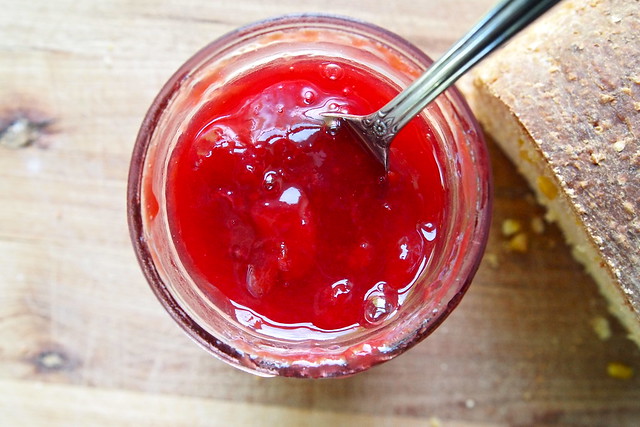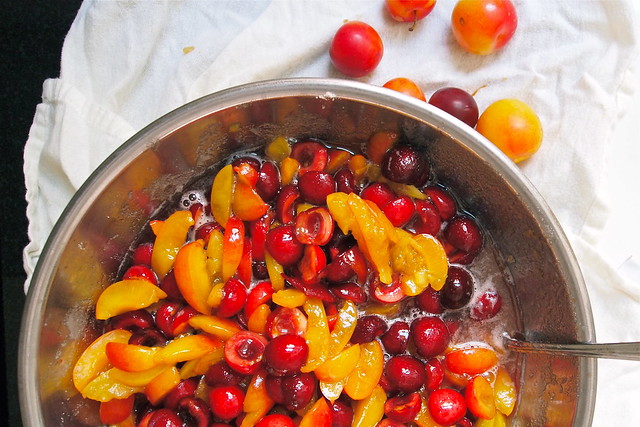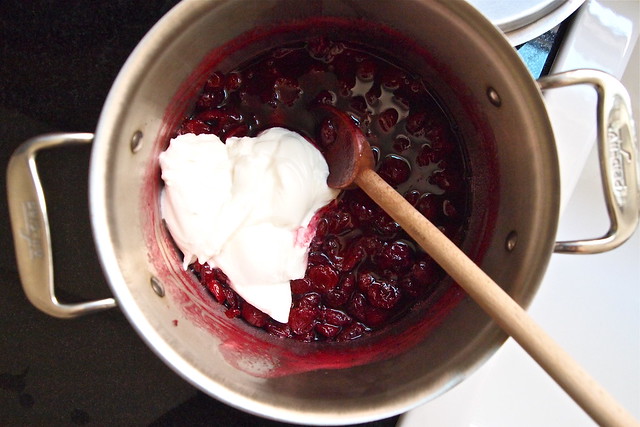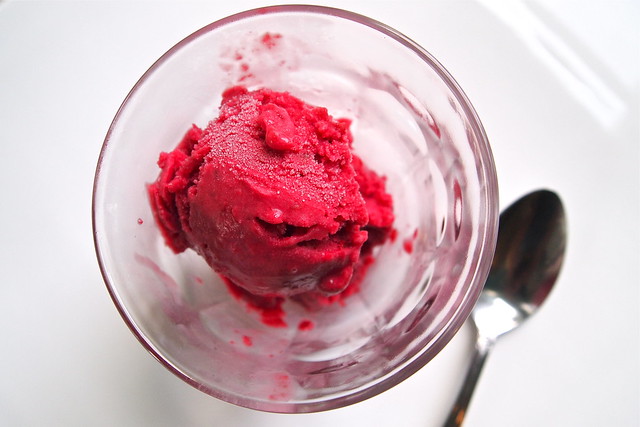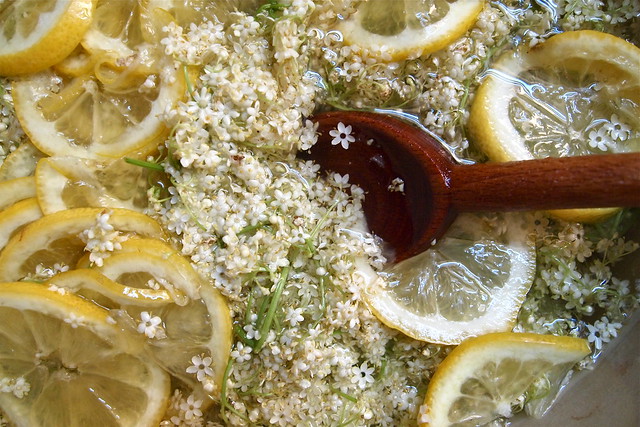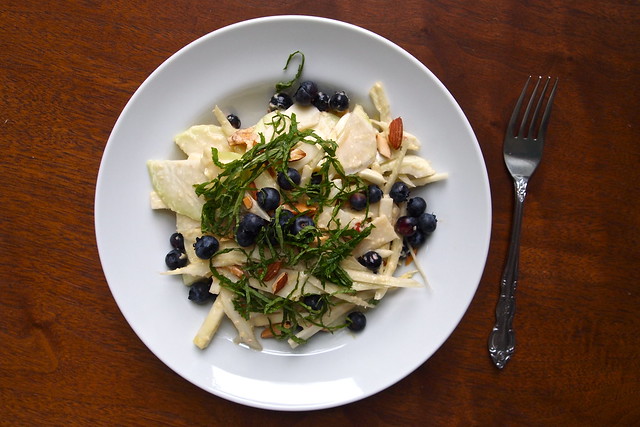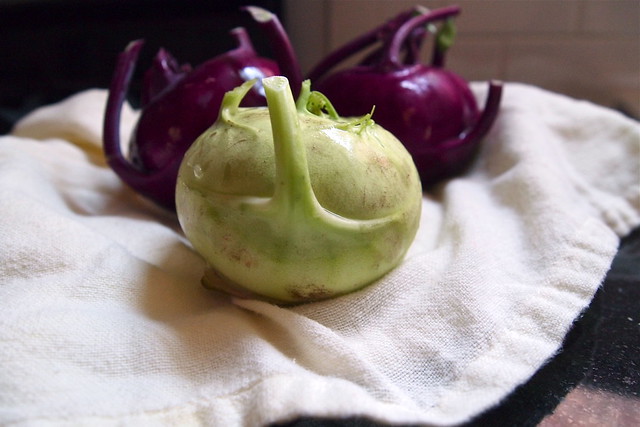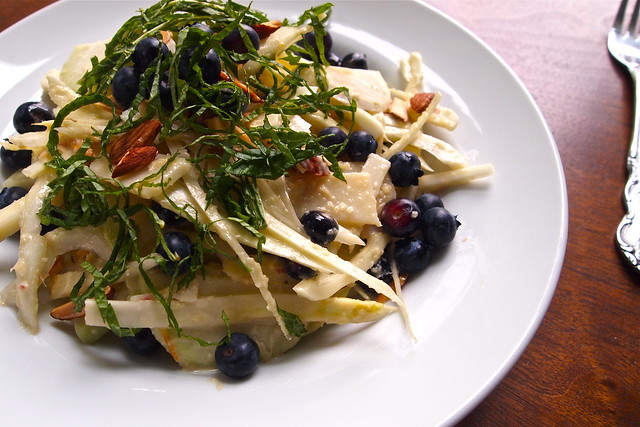I know, I know, another batch of preserves--what gives? I've been asking that of myself a lot lately, and I still don't have much of an answer. I've just found myself this summer making jam feverishly--and not only that but thinking a lot about it (also feverishly)--about what went well and what didn't with past batches, about how to squeeze in another session soon, about what to make next. It's all gotten, I admit, just a little bit obsessive. And before this, if you can believe it, jam wasn't something that really held my interest. Butter, I thought, is all a girl really needs. Why complicate matters?
Why, indeed, complicate matters? That was, for a long time, my attitude towards summer fruit. Berries, peaches, and plums--why fuss with them when they're good as they are? On a sticky July day, you can't do much better for yourself than eating a cold plum over the kitchen sink, juices running down your arms. So why trouble yourself with more? But then twice last week I found myself in the kitchen sweating it out over a pot of bubbling fruit and sugar, glass jars close at hand waiting to be filled. So obviously, at some point, I'd undergone a change of mind.
It had a lot to do with the process, I think. Making preserves is very physical, very absorbing--pulling apart cherries one by one and plucking out their pits or slicing up a mound of plums. You give more attention to the fruit than you might just sticking it in your mouth, and it feels good. And the transformation that takes place, because it happens in an open pan, and because you're there the whole time, stirring, stirring, stirring, is one you get to see all the way through. You get to see the fruit slump and soften. You get to see the sugar disappear into the juices, and the juices bubble up wildly and thicken. It's dramatic and beautiful. You get a different appreciation of the fruit. And you feel like you're tapping into something old, elemental, deeply human.
This, anyway, is the feeling I'm left with, having recently read and swooned over much of Kevin West's Saving the Season. The book is a bit unusual for a cookbook. West provides plenty of clear instruction and assurance on pickles, jams, jellies, and the like. But he also contextualizes preservation as a practice. Between recipes, he draws on a mixture of history, literature, and personal narrative to give us a better sense of the fruits, vegetables, and processes to follow. You get the feeling reading it that you're being given an heirloom, something enduring to hold on to. I'm pretty sure that I'll be turning to the book season after season, year after year, for a long time. (Before the book, West wrote a blog by the same name. I suggest you check on his post on quince, if you want to get the flavour of his work. It's heady.)
This latest batch is from the book, a mixture of early plums and sweet cherries, finished with a splash of bourbon. I didn't make it quite as intended. I was supposed to use inky-dark Bing cherries, but in a moment of absentmindedness at the market, I ended up with a brighter, less assertive variety. So my preserves don't quite have the depth and colour they're supposed to. But I don't really mind. Instead, they have a sort of all-round, stone-fruit sunniness to them, something I know I'll appreciate come January. My favourite spoonfuls are the ones that include a slice of plum. The fruit is velvety, yielding in the best way. And with the bourbon, it is made luxurious, buttery even.
Cherry Preserves with Plums
From Kevin West's Saving the Season
NOTE: Fruit obviously varies in sweetness. The measurements provided for both sugar and lemon juice are therefore guidelines only. West encourages you to taste your fruit at every stage of the process--out of hand, once macerated, and during reduction (after a minute on one of those chilled plates). Adjust with more sugar or lemon juice as you see fit. West also advises starting out with a little less (up to a 1/2 cup less) sugar, depending on the plum varieties available to you. You can always add more sugar towards the end, if you don't think the preserves are sweet enough.
2 pounds black cherries, such as Bing
2 pounds firm, yellow-fleshed plums, such as Red Beauty (the tarter, the better)
2 tablespoons freshly squeezed lemon juice
3 cups sugar
1/4 cup bourbon or brandy
Wash and drain the fruit. Pit the cherries. (West isn't one for cherry-pitters. His method is to grab each cherry, one thumb on either side of the stem, and pull it apart. It should split lengthwise along its seam. Then you can just dig out the pit. This works best, I've found, with soft, ripe cherries. It makes less of a mess than a pitter.) Slice the plums away from their pits in sections. Stir together the fruit, lemon juice, and sugar. Set aside to macerate for at least 15 minutes. (If you plan to macerate for longer, e.g. overnight, press a piece of parchment paper or plastic wrap close to the fruit to prevent oxidation.)
Set a few small plates in the freezer. Warm 5 clean half-pint jars and lids in the oven set at 200 degrees F.
Turn the fruit-sugar mixture into a preserving pan or other large, wide, heavy-bottomed pot. Reduce over high heat, stirring frequently. Once it comes to a full rolling boil, it should take 10-12 more minutes to fully reduce. Test the preserves. Turn off the heat and spoon about a teaspoon's worth onto one of the chilled plates. Return it to the freezer for 1 minute. If the surface wrinkles when you push your finger through it, it's ready. If not, continue reducing for a couple minutes more and test the consistency again. Once fully reduced, add the brandy or bourbon and continue to cook, stirring well, for 1 minute longer.
Ladle the hot preserves into the five half-pint jars, leaving 1/4-inch headspace. Wipe the jars' rims clean and put on their lids and bands (screwed only finger-tight).
Process in a boiling-water bath for 10 minutes (count 10 minutes from when the water returns to a boil). Remove the jars from the water and let cool. Check to see if a proper seal has formed by removing each jar's band and holding the jar by its lid. The lid should hold firm. If it doesn't, store the jar in the fridge and eat its contents promptly.
Makes about 5 1/2-pint jars.
Makes about 5 1/2-pint jars.

